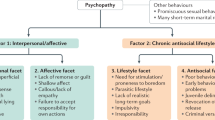Abstract
Psychopathy is a disorder involving personality and behavioral features associated with a high rate of violent aggression and recidivism. This paper explores potential psychopharmacological therapies to modulate dysfunctional neural pathways in psychopaths and reduce the incidence of their harmful behavior, as well as the ethical and legal implications of offering these therapies as an alternative to incarceration. It also considers whether forced psychopharmacological intervention in adults and children with psychopathic traits manifesting in violent behavior can be justified. More generally, the paper addresses the question of how to weigh the psychopath’s presumptive right to non-interference in his brain and mind against the public interest in avoiding harm.
Similar content being viewed by others
Notes
Personal correspondence with James Blair, June 2008.
References
Cleckley, Hervey. 1982. The mask of sanity. Rev. ed. St. Louis: Mosby.
Hare, Robert. 2003. Hare psychopathy checklist-revised (PCL-R). 2nd ed. Toronto: Multi-Health Systems.
Blair, R.James R., Derek Mitchell, and Karina Blair. 2005. The psychopath: Emotion and the brain. Malden, MA: Blackwell.
Blair, R.James R. 2003. Neurobiological basis of psychopathy. British Journal of Psychiatry 182: 5–7.
Blair, R.James R. 2007. Aggression, psychopathy, and free will from a cognitive neuroscience perspective. Behavioral Sciences and the Law 25: 321–331.
Blair, R.James R. 2008. The cognitive neuroscience of psychopathy and implications for judgments of responsibility. Neuroethics 1(3): 149–157.
Glenn, Andrea, and Adrian Raine. 2009. Psychopathy and instrumental aggression: Evolutionary, neurobiological, and legal perspectives. International Journal of Law and Psychiatry 32: 253–258.
Glenn, Andrea, Adrian Raine, and Robert Schug. 2009. The neural correlates of moral decision-making in psychopathy. Molecular Psychiatry 14: 5–6.
Decety, Jean, Kalina Michalska, and Katherine Kinzler. 2012. The contribution of emotion and cognition to moral sensitivity: A neurodevelopmental study. Cerebral Cortex 22: 209–220.
Decety, Jean, and William Ickes (eds.). 2011. The social neuroscience of empathy. Cambridge, MA: MIT Press.
Crockett, Molly, Luke Clark, Marc Hauser, and Trevor Robbins. 2010. Serotonin selectively influences moral judgment and behavior through effects on harm aversion. Proceedings of the National Academy of Sciences 107: 17433–17438.
Crockett, Molly. 2013. Moral bioenhancement: A neuroscientific perspective. Journal of Medical Ethics. doi:10.1136/medethics-2012-101096.
Ross, Heather, and Larry Young. 2009. Oxytocin and the neural mechanisms regulating social cognition and affiliative behavior. Frontiers in Neuroendocrinology 30: 534–547.
Churchland, Patricia Smith. 2011. Braintrust. Princeton: Princeton University Press.
Bartz, Jennifer, Jamil Zaki, Niall Bolger, and Kevin Ochsner. 2011. Social effects of oxytocin in humans: Context and person matter. Trends in Cognitive Sciences 15: 301–309.
Young, Liane, Joan Albert Camprodon, Marc Hauser, Alvaro Pascual-Leone, and Rebecca Saxe. 2010. Disruption of the right temporoparietal junction with transcranial magnetic stimulation reduces the role of beliefs in moral judgments. Proceedings of the National Academy of Sciences 107: 6753–6758.
Rabins, Peter, Brian Appleby, Jason Brandt, et al. 2009. Scientific and ethical issues related to deep-brain stimulation for disorders of mood, behavior, and thought. Archives of General Psychiatry 66: 931–937.
Buckholtz, Joshua, Michael Treadway, Ronald Cowan, et al. 2010. Mesolimbic dopamine reward system hypersensitivity in individuals with psychopathic traits. Nature Neuroscience 13: 419–424.
Grisso, Thomas, and Paul Appelbaum. 1998. Assessing competence to consent to treatment: A guide for physicians and other health professionals. New York: Oxford University Press.
Beauchamp, Tom, and James Childress. 2009. Principles of biomedical ethics. 6th ed. New York: Oxford University Press.
Wertheimer, Alan. 1987. Coercion. Princeton: Princeton University Press.
Bomann-Larsen, Lene. 2013. Voluntary rehabilitation? On neurotechnological behavioral treatment, valid consent, and (in)appropriate offers. Neuroethics 6(1): 65–77.
Frankfurt, Harry. 1988. Coercion and moral responsibility. In The importance of what we care about, 26–46. New York: Cambridge University Press.
Zimmerman, David. 1981. Coercive wage offers. Philosophy and Public Affairs 10: 121–145.
Chandler, Jennifer. 2013. Autonomy and the unintended legal consequences of emerging neurotherapies. Neuroethics 6(2): 249–263.
Greely, Henry. 2008. Neuroscience and criminal justice: Not responsibility but treatment. Kansas Law Review 56: 1103–1138.
Morse, Stephen. 2008. Psychopathy and criminal responsibility. Neuroethics 1(3): 205–212.
Fine, Cordelia, and Jeannette Kennett. 2004. Mental impairment, moral understanding, and criminal responsibility: Psychopathy and the purposes of punishment. International Journal of Law and Psychiatry 27: 425–443.
Focquaert, Farah, Andrea Glenn, and Adrian Raine. 2014. Psychopathy and free will. In Free will and the brain: Neuroscientific, philosophical and legal perspectives, ed. Walter Glannon. Cambridge: Cambridge University Press.
Viding, Essi, James Blair, Terrie Moffitt, and Robert Plomin. 2005. Evidence for substantial genetic risk for psychopathy in 7-year-olds. Journal of Child Psychology and Psychiatry 46: 592–597.
Morse, Stephen. 2011. Genetics and criminal responsibility. Trends in Cognitive Sciences 15: 378–380.
Blair, R.James R. 2013. The neurobiology of psychopathic traits in youths. Nature Reviews Neuroscience 14: 786–799.
Rutter, Michael. 2012. Psychopathy in childhood: Is it a meaningful diagnosis? British Journal of Psychiatry 200: 175–176.
Acknowledgments
I am grateful to an anonymous reviewer for helpful comments on an earlier version of this article, as well as to an audience at the Institut de Recherches Cliniques de Montreal in March 2012. The writing of the article was made possible in part by the support of a grant from the John Templeton Foundation. The views expressed in this paper are those of the author and do not necessarily reflect those of the John Templeton Foundation.
Author information
Authors and Affiliations
Corresponding author
Rights and permissions
About this article
Cite this article
Glannon, W. Intervening in the psychopath’s brain. Theor Med Bioeth 35, 43–57 (2014). https://doi.org/10.1007/s11017-013-9275-z
Published:
Issue Date:
DOI: https://doi.org/10.1007/s11017-013-9275-z




